TOYOTA COROLLA HATCHBACK 2020 Warranties & Maintenance Guides (in English)
Manufacturer: TOYOTA, Model Year: 2020, Model line: COROLLA HATCHBACK, Model: TOYOTA COROLLA HATCHBACK 2020Pages: 260, PDF Size: 8.54 MB
Page 241 of 260
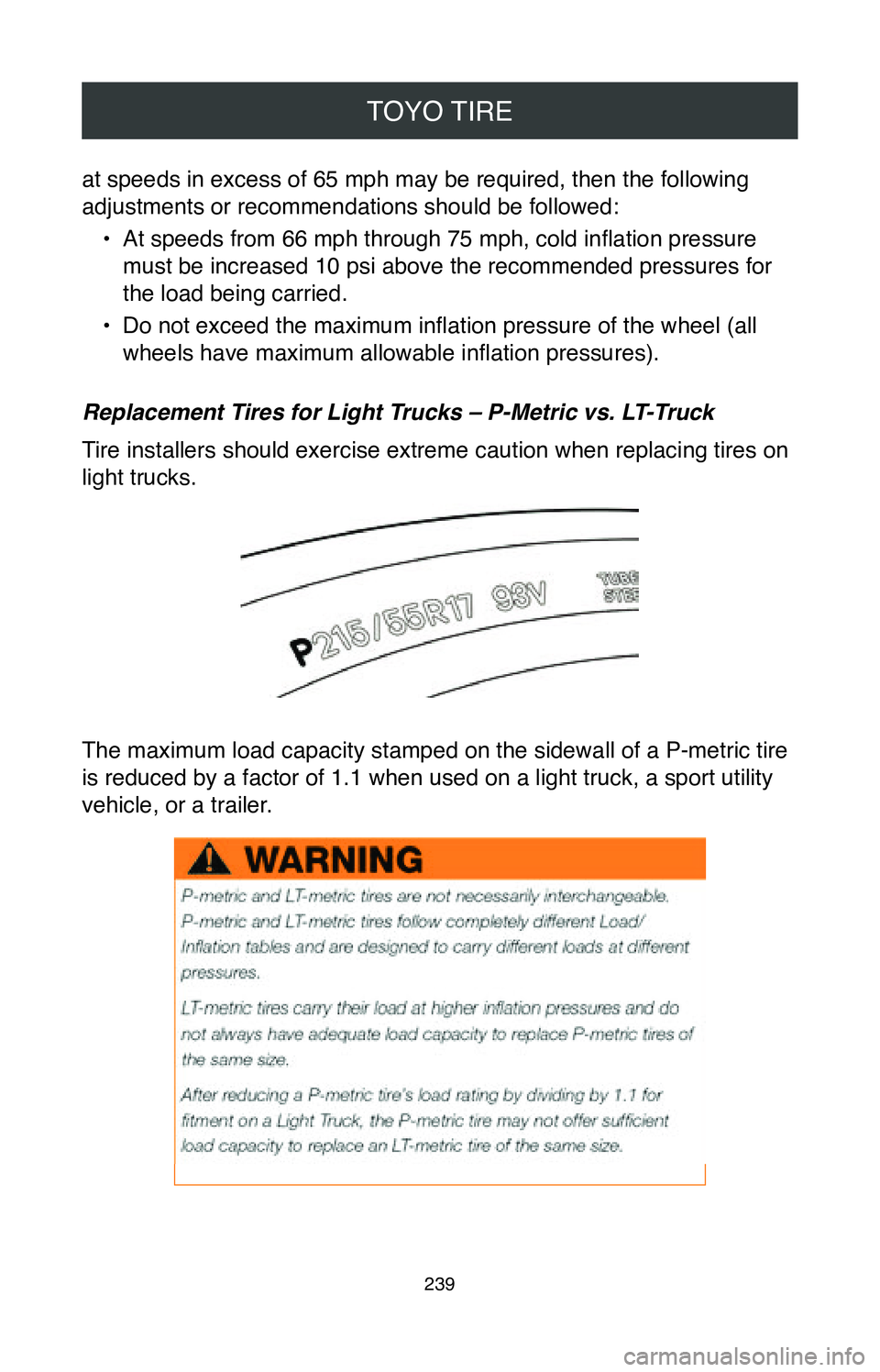
TOYO TIRE
239
at speeds in excess of 65 mph may be required, then the following
adjustments or recommendations should be followed:•
At speeds from 66 mph through 75 mph, cold inflation pressure
must be increased 10 psi above the recommended pressures for
the load being carried.
•
Do not exceed the maximum inflation pressure of the wheel (all
wheels have maximum allowable inflation pressures).
Replacement Tires for Light Trucks – P-Metric vs. LT-Truck
Tire installers should exercise extreme caution when replacing tires on
light trucks.
The maximum load capacity stamped on the sidewall of a P-metric tire
is reduced by a factor of 1.1 when used on a light truck, a sport utilit\
y
vehicle, or a trailer.
Page 242 of 260
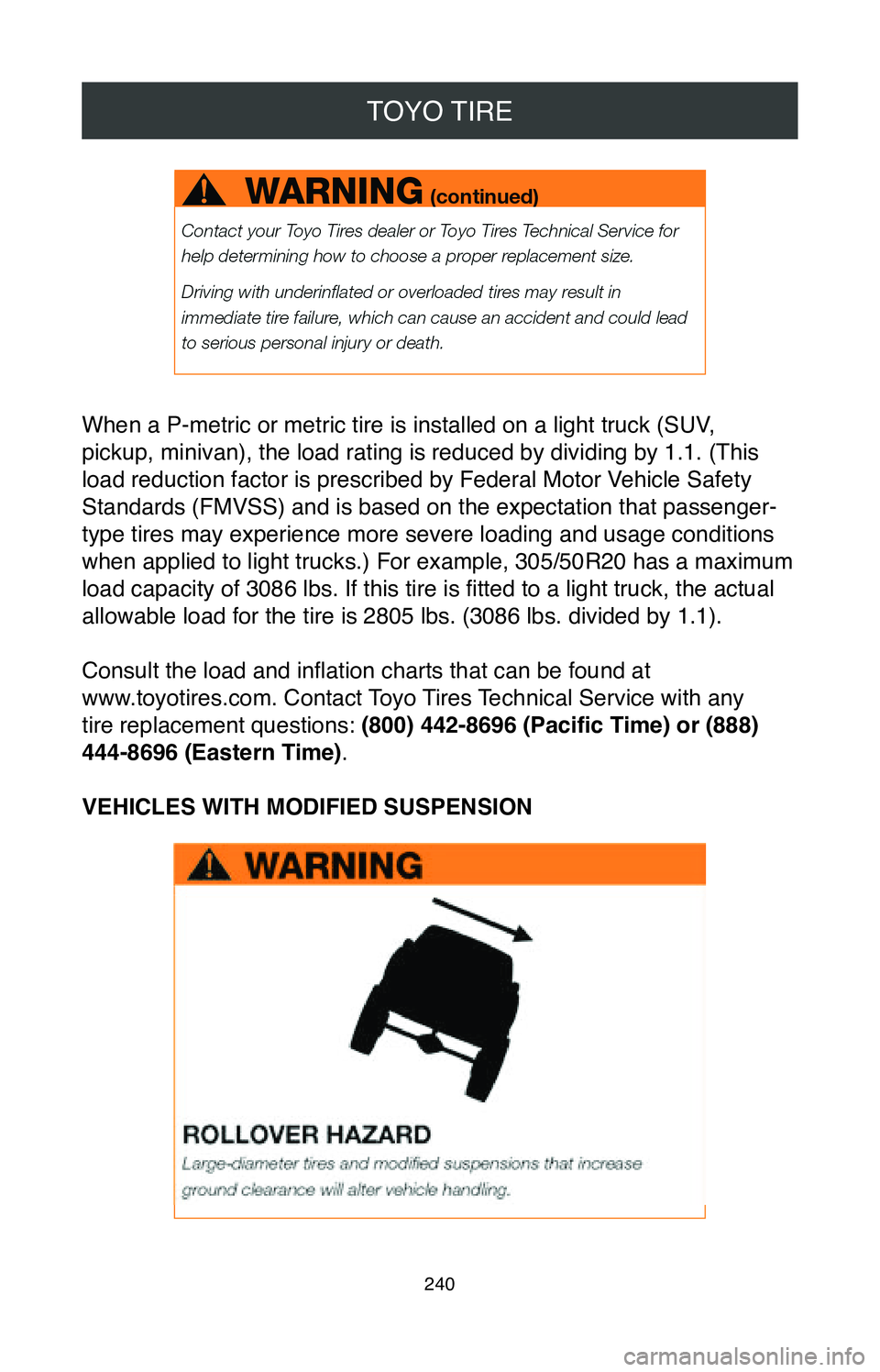
TOYO TIRE
240
When a P-metric or metric tire is installed on a light truck (SUV,
pickup, minivan), the load rating is reduced by dividing by 1.1. (This
load reduction factor is prescribed by Federal Motor Vehicle Safety
Standards (FMVSS) and is based on the expectation that passenger-
type tires may experience more severe loading and usage conditions
when applied to light trucks.) For example, 305/50R20 has a maximum
load capacity of 3086 lbs. If this tire is fitted to a light truck, the actual
allowable load for the tire is 2805 lbs. (3086 lbs. divided by 1.1).
Consult the load and inflation charts that can be found at
www.toyotires.com. Contact Toyo Tires Technical Service with any
tire replacement questions: (800) 442
-8696 (Pacific Time) or (888)
444
-8696 (Eastern Time).
VEHICLES WITH MODIFIED SUSPENSION
Page 243 of 260
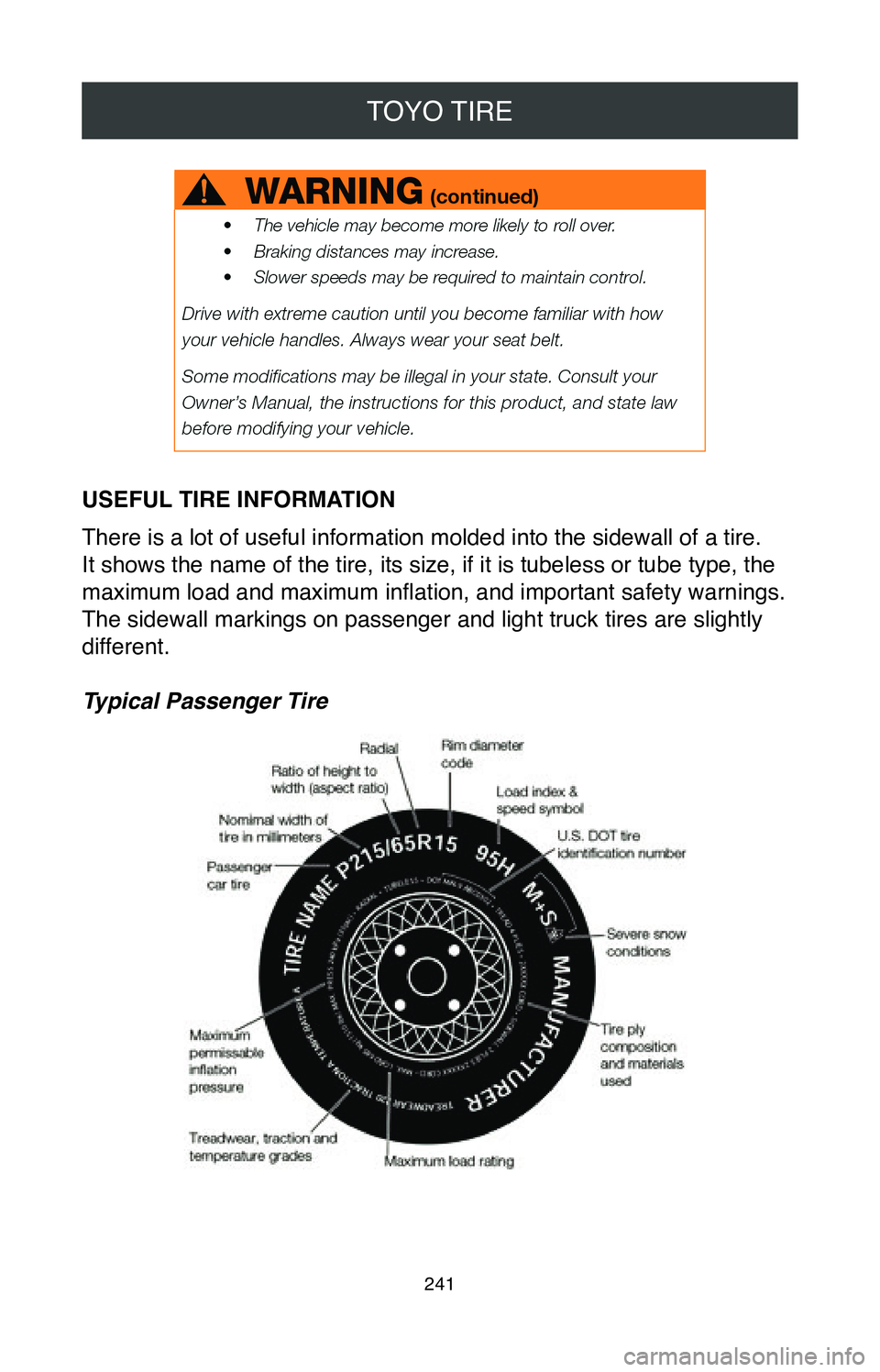
TOYO TIRE
241
USEFUL TIRE INFORMATION
There is a lot of useful information molded into the sidewall of a tire.\
It shows the name of the tire, its size, if it is tubeless or tube type,\
the
maximum load and maximum inflation, and important safety warnings.
The sidewall markings on passenger and light truck tires are slightly
different.
Typical Passenger Tire
Page 244 of 260
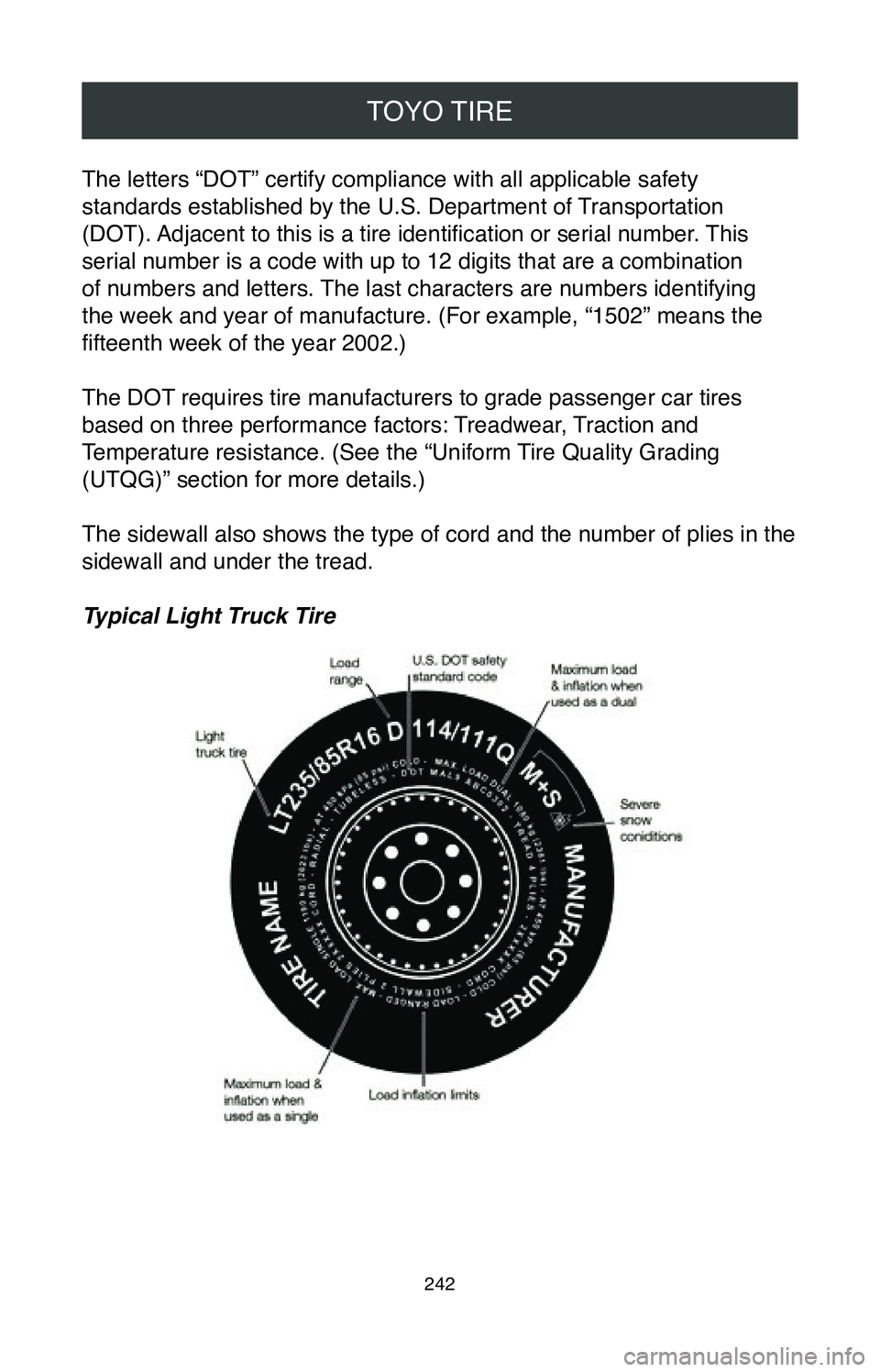
TOYO TIRE
242
The letters “DOT” certify compliance with all applicable safety
standards established by the U.S. Department of Transportation
(DOT). Adjacent to this is a tire identification or serial number. This
serial number is a code with up to 12 digits that are a combination
of numbers and letters. The last characters are numbers identifying
the week and year of manufacture. (For example, “1502” means the
fifteenth week of the year 2002.)
The DOT requires tire manufacturers to grade passenger car tires
based on three performance factors: Treadwear, Traction and
Temperature resistance. (See the “Uniform Tire Quality Grading
(UTQG)” section for more details.)
The sidewall also shows the type of cord and the number of plies in the \
sidewall and under the tread.
Typical Light Truck Tire
Page 245 of 260
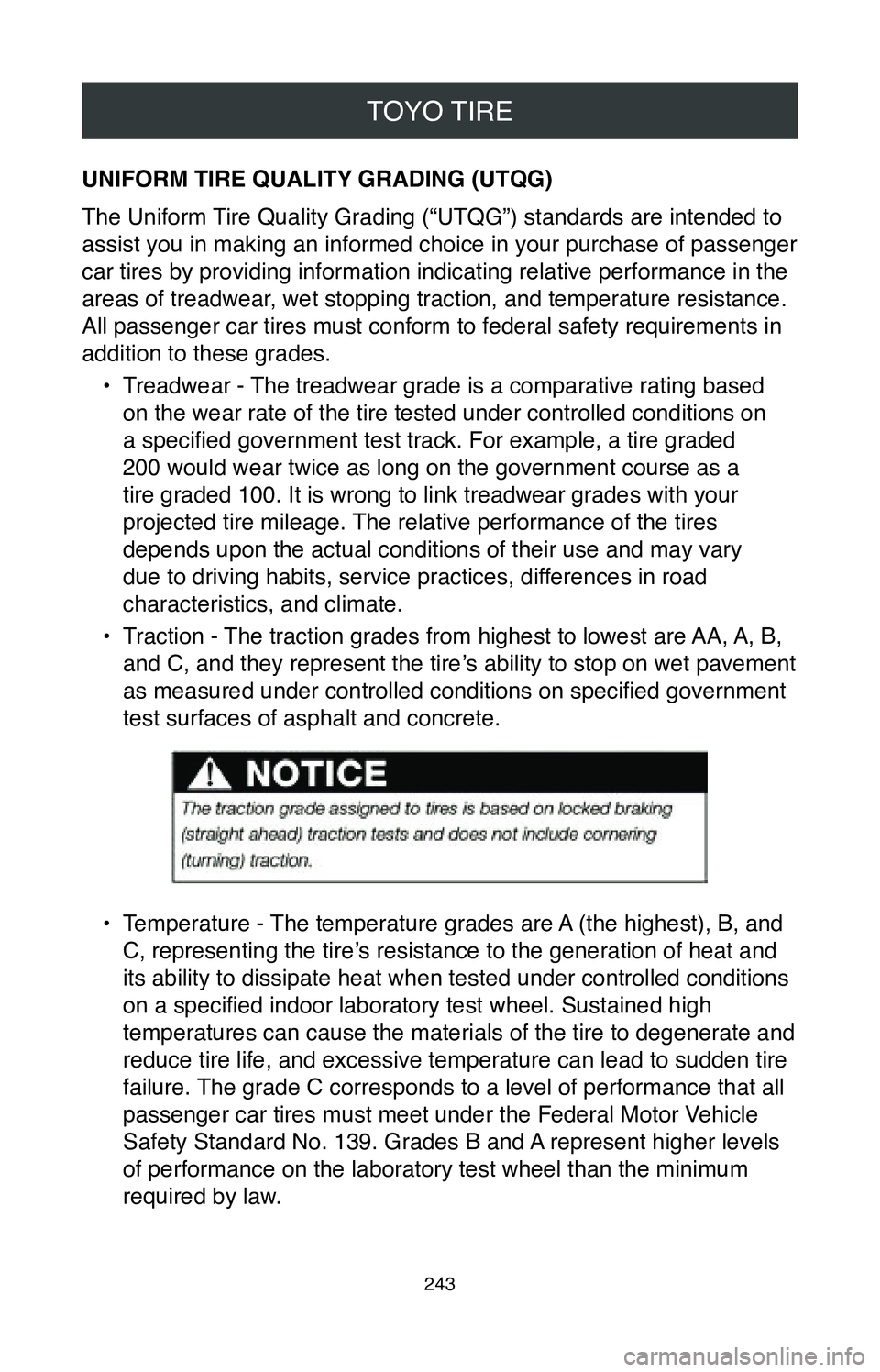
TOYO TIRE
243
UNIFORM TIRE QUALITY GRADING (UTQG)
The Uniform Tire Quality Grading (“UTQG”) standards are intended to
assist you in making an informed choice in your purchase of passenger
car tires by providing information indicating relative performance in th\
e
areas of treadwear, wet stopping traction, and temperature resistance.
All passenger car tires must conform to federal safety requirements in
addition to these grades.•
Treadwear - The treadwear grade is a comparative rating based
on the wear rate of the tire tested under controlled conditions on
a specified government test track. For example, a tire graded
200 would wear twice as long on the government course as a
tire graded 100. It is wrong to link treadwear grades with your
projected tire mileage. The relative performance of the tires
depends upon the actual conditions of their use and may vary
due to driving habits, service practices, differences in road
characteristics, and climate.
•
Traction - The traction grades from highest to lowest are AA, A, B,
and C, and they represent the tire’s ability to stop on wet pavement
as measured under controlled conditions on specified government
test surfaces of asphalt and concrete.
• Temperature - The temperature grades are A (the highest), B, and
C, representing the tire’s resistance to the generation of heat and
its ability to dissipate heat when tested under controlled conditions
on a specified indoor laboratory test wheel. Sustained high
temperatures can cause the materials of the tire to degenerate and
reduce tire life, and excessive temperature can lead to sudden tire
failure. The grade C corresponds to a level of performance that all
passenger car tires must meet under the Federal Motor Vehicle
Safety Standard No. 139. Grades B and A represent higher levels
of performance on the laboratory test wheel than the minimum
required by law.
Page 246 of 260
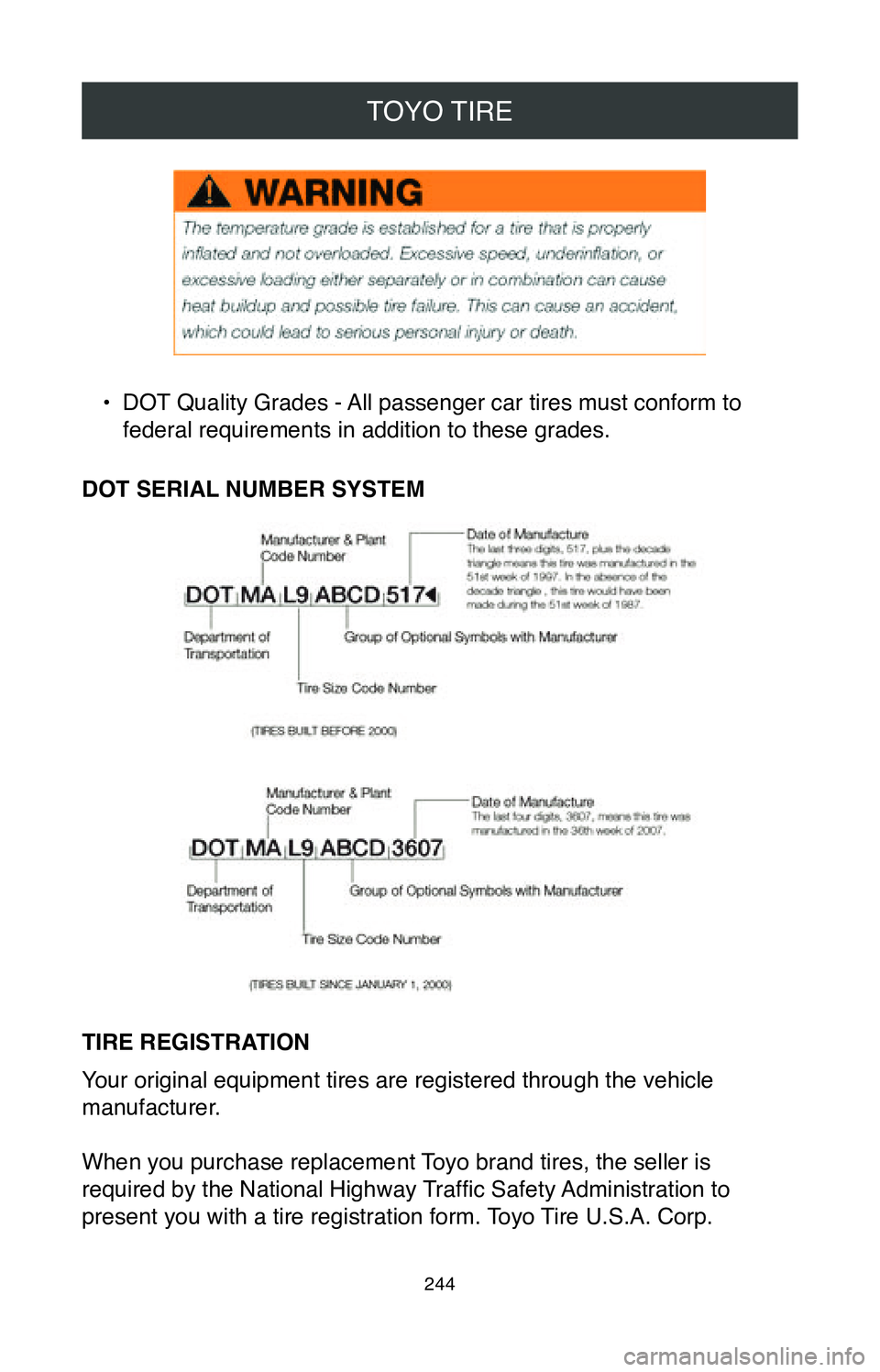
TOYO TIRE
244
• DOT Quality Grades - All passenger car tires must conform to
federal requirements in addition to these grades.
DOT SERIAL NUMBER SYSTEM
TIRE REGISTRATION
Your original equipment tires are registered through the vehicle
manufacturer.
When you purchase replacement Toyo brand tires, the seller is
required by the National Highway Traffic Safety Administration to
present you with a tire registration form. Toyo Tire U.S.A. Corp.
Page 247 of 260
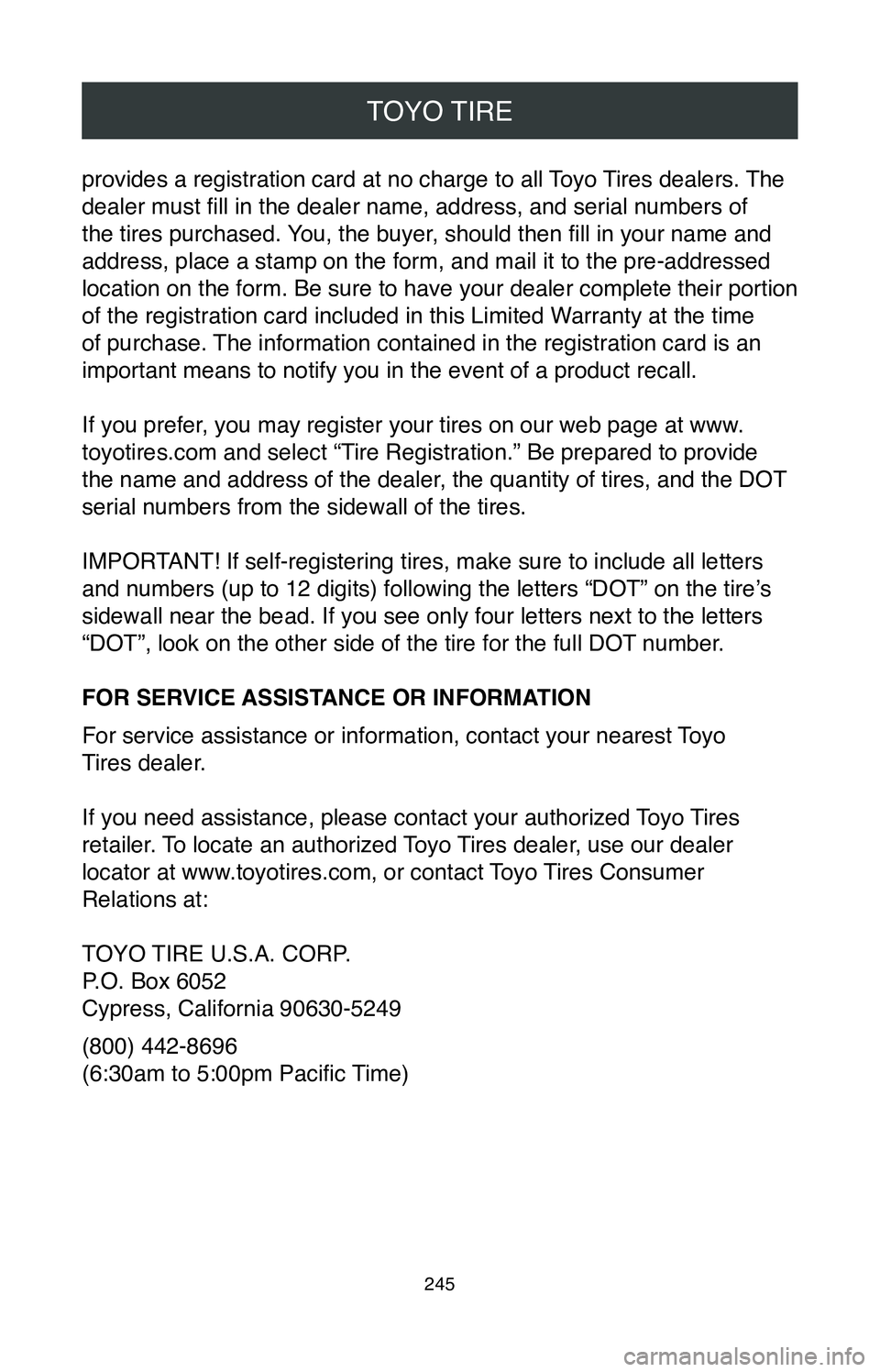
TOYO TIRE
245
provides a registration card at no charge to all Toyo Tires dealers. The
dealer must fill in the dealer name, address, and serial numbers of
the tires purchased. You, the buyer, should then fill in your name and
address, place a stamp on the form, and mail it to the pre-addressed
location on the form. Be sure to have your dealer complete their portion
of the registration card included in this Limited Warranty at the time
of purchase. The information contained in the registration card is an
important means to notify you in the event of a product recall.
If you prefer, you may register your tires on our web page at www.
toyotires.com and select “Tire Registration.” Be prepared to provide
the name and address of the dealer, the quantity of tires, and the DOT
serial numbers from the sidewall of the tires.
IMPORTANT! If self-registering tires, make sure to include all letters
and numbers (up to 12 digits) following the letters “DOT” on the tire’s
sidewall near the bead. If you see only four letters next to the letters\
“DOT”, look on the other side of the tire for the full DOT number.
FOR SERVICE ASSISTANCE OR INFORMATION
For service assistance or information, contact your nearest Toyo
Tires dealer.
If you need assistance, please contact your authorized Toyo Tires
retailer. To locate an authorized Toyo Tires dealer, use our dealer
locator at www.toyotires.com, or contact Toyo Tires Consumer
Relations at:
TOYO TIRE U.S.A. CORP.
P.O. Box 6052
Cypress, California 90630-5249
(800) 442-8696
(6:30am to 5:00pm Pacific Time)
Page 248 of 260
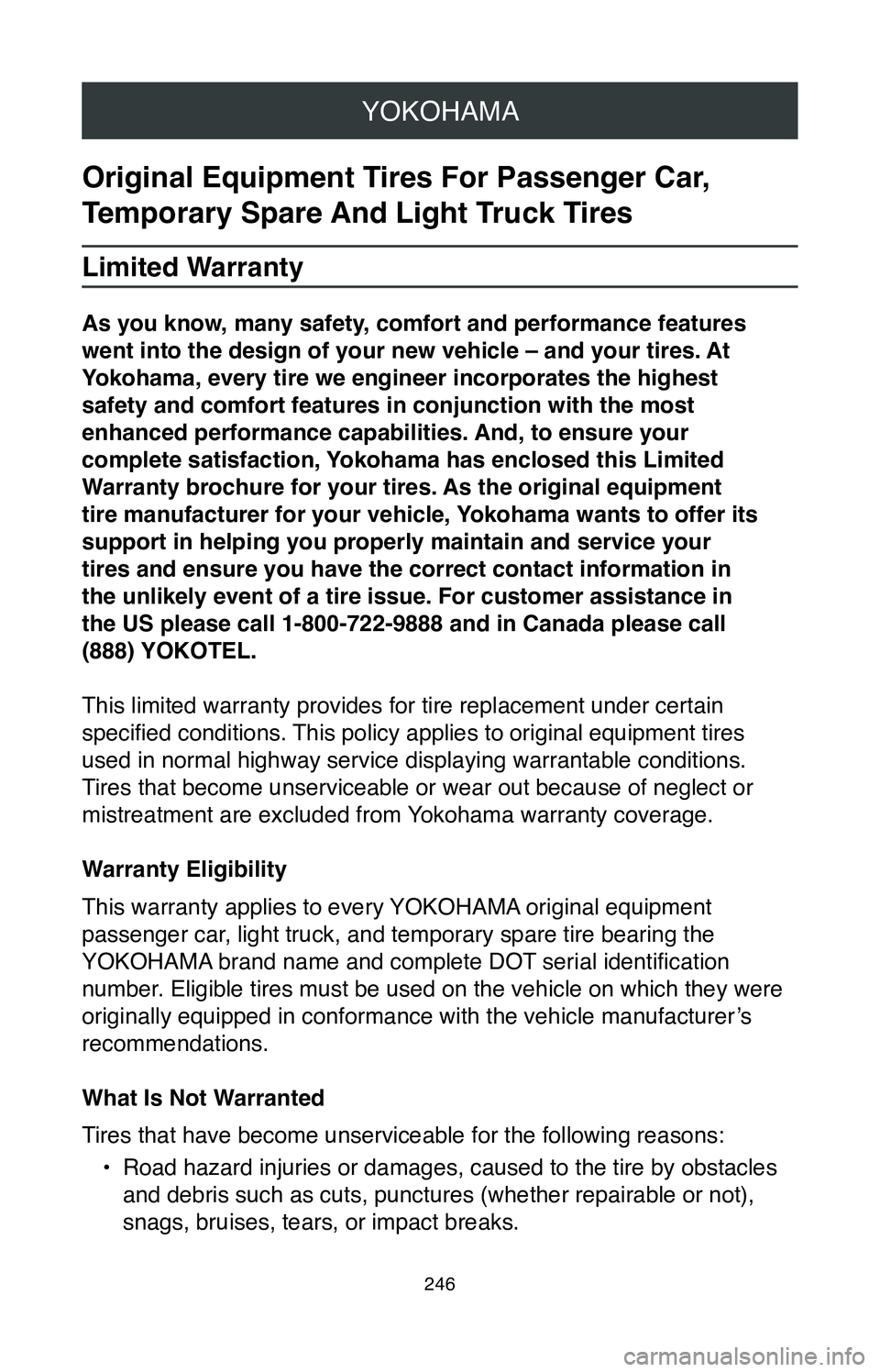
YOKOHAMA
246
Original Equipment Tires For Passenger Car,
Temporary Spare And Light Truck Tires
Limited Warranty
As you know, many safety, comfort and performance features
went into the design of your new vehicle – and your tires. At
Yokohama, every tire we engineer incorporates the highest
safety and comfort features in conjunction with the most
enhanced performance capabilities. And, to ensure your
complete satisfaction, Yokohama has enclosed this Limited
Warranty brochure for your tires. As the original equipment
tire manufacturer for your vehicle, Yokohama wants to offer its
support in helping you properly maintain and service your
tires and ensure you have the correct contact information in
the unlikely event of a tire issue. For customer assistance in
the US please call 1-800-722-9888 and in Canada please call
(888) YOKOTEL.
This limited warranty provides for tire replacement under certain
specified conditions. This policy applies to original equipment tires
used in normal highway service displaying warrantable conditions.
Tires that become unserviceable or wear out because of neglect or
mistreatment are excluded from Yokohama warranty coverage.
Warranty Eligibility
This warranty applies to every YOKOHAMA original equipment
passenger car, light truck, and temporary spare tire bearing the
YOKOHAMA brand name and complete DOT serial identification
number. Eligible tires must be used on the vehicle on which they were
originally equipped in conformance with the vehicle manufacturer ’s
recommendations.
What Is Not Warranted
Tires that have become unserviceable for the following reasons:
•
Road hazard injuries or damages, caused to the tire by obstacles
and debris such as cuts, punctures (whether repairable or not),
snags, bruises, tears, or impact breaks.
Page 249 of 260
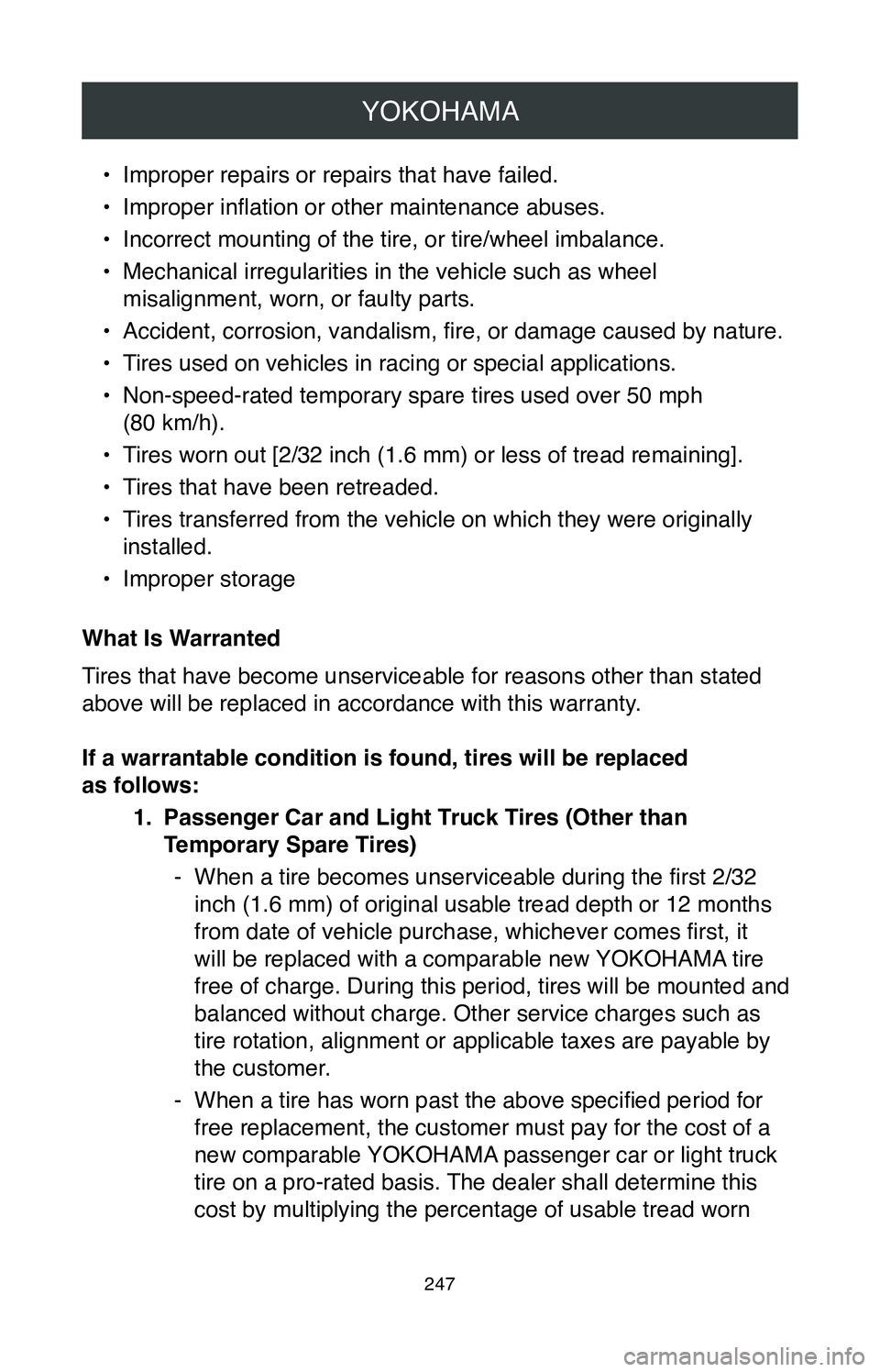
YOKOHAMA
247
• Improper repairs or repairs that have failed.
•
Improper inflation or other maintenance abuses.
•
Incorrect mounting of the tire, or tire/wheel imbalance.
•
Mechanical irregularities in the vehicle such as wheel
misalignment, worn, or faulty parts.
•
Accident, corrosion, vandalism, fire, or damage caused by nature.
•
Tires used on vehicles in racing or special applications.
•
Non-speed-rated temporary spare tires used over 50 mph
(80 km/h).
•
Tires worn out [2/32 inch (1.6 mm) or less of tread remaining].
•
Tires that have been retreaded.
•
Tires transferred from the vehicle on which they were originally
installed.
•
Improper storage
What Is Warranted
Tires that have become unserviceable for reasons other than stated
above will be replaced in accordance with this warranty.
If a warrantable condition is found, tires will be replaced
as follows: 1.
Passenger Car and Light Truck Tires (Other than
Temporary Spare Tires)
- When a tire becomes unserviceable during the first 2/32 inch (1.6 mm) of original usable tread depth or 12 months
from date of vehicle purchase, whichever comes first, it
will be replaced with a comparable new YOKOHAMA tire
free of charge. During this period, tires will be mounted and
balanced without charge. Other service charges such as
tire rotation, alignment or applicable taxes are payable by
the customer.
- When a tire has worn past the above specified period for free replacement, the customer must pay for the cost of a
new comparable YOKOHAMA passenger car or light truck
tire on a pro-rated basis. The dealer shall determine this
cost by multiplying the percentage of usable tread worn
Page 250 of 260
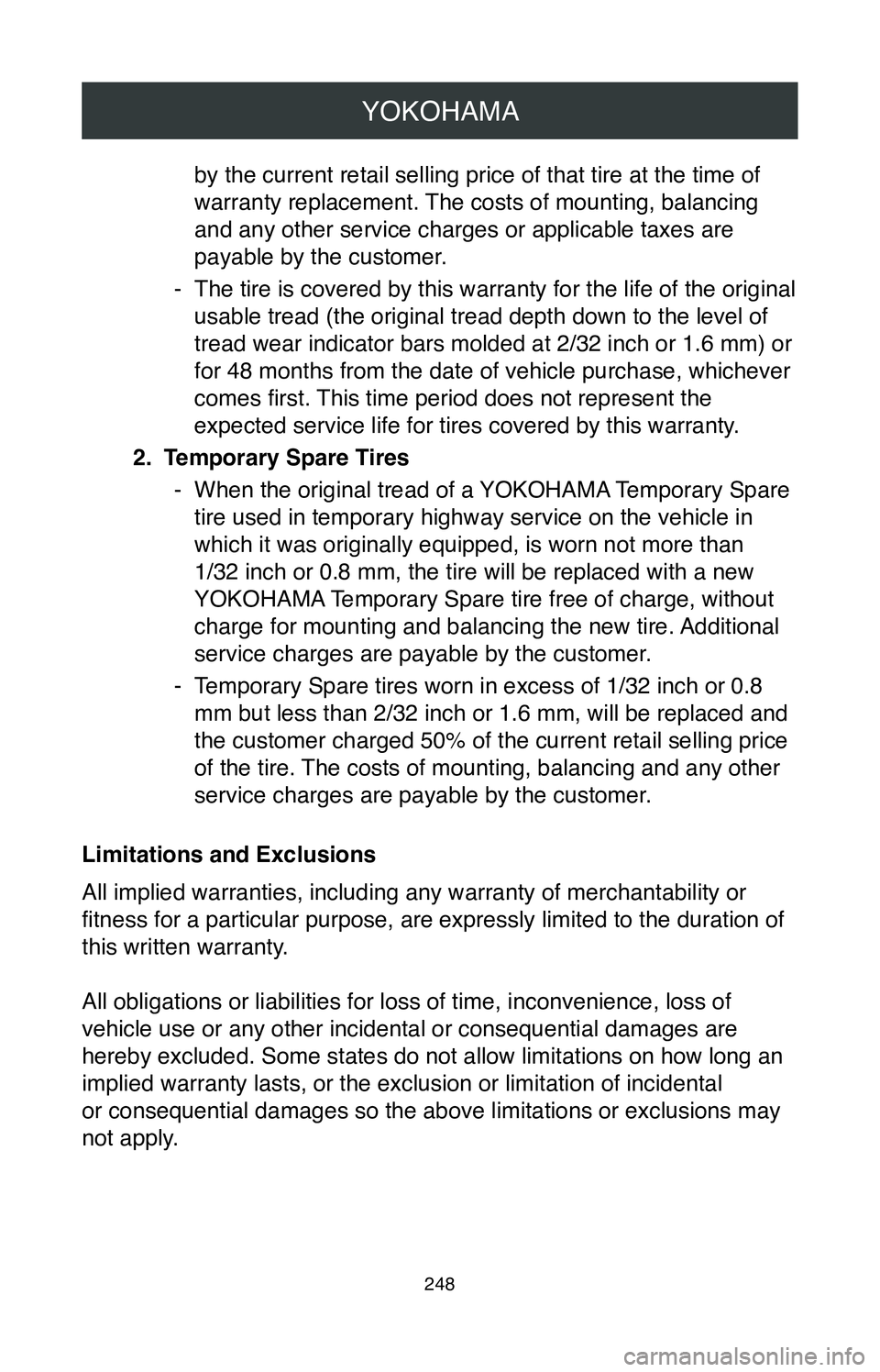
YOKOHAMA
248
by the current retail selling price of that tire at the time of
warranty replacement. The costs of mounting, balancing
and any other service charges or applicable taxes are
payable by the customer.
-The tire is covered by this warranty for the life of the original
usable tread (the original tread depth down to the level of
tread wear indicator bars molded at 2/32 inch or 1.6 mm) or
for 48 months from the date of vehicle purchase, whichever
comes first. This time period does not represent the
expected service life for tires covered by this warranty.
2.
Temporary Spare Tires
- When the original tread of a YOKOHAMA Temporary Spare
tire used in temporary highway service on the vehicle in
which it was originally equipped, is worn not more than
1/32 inch or 0.8 mm, the tire will be replaced with a new
YOKOHAMA Temporary Spare tire free of charge, without
charge for mounting and balancing the new tire. Additional
service charges are payable by the customer.
-Temporary Spare tires worn in excess of 1/32 inch or 0.8
mm but less than 2/32 inch or 1.6 mm, will be replaced and
the customer charged 50% of the current retail selling price
of the tire. The costs of mounting, balancing and any other
service charges are payable by the customer.
Limitations and Exclusions
All implied warranties, including any warranty of merchantability or
fitness for a particular purpose, are expressly limited to the duration of
this written warranty.
All obligations or liabilities for loss of time, inconvenience, loss of \
vehicle use or any other incidental or consequential damages are
hereby excluded. Some states do not allow limitations on how long an
implied warranty lasts, or the exclusion or limitation of incidental
or consequential damages so the above limitations or exclusions may
not apply.